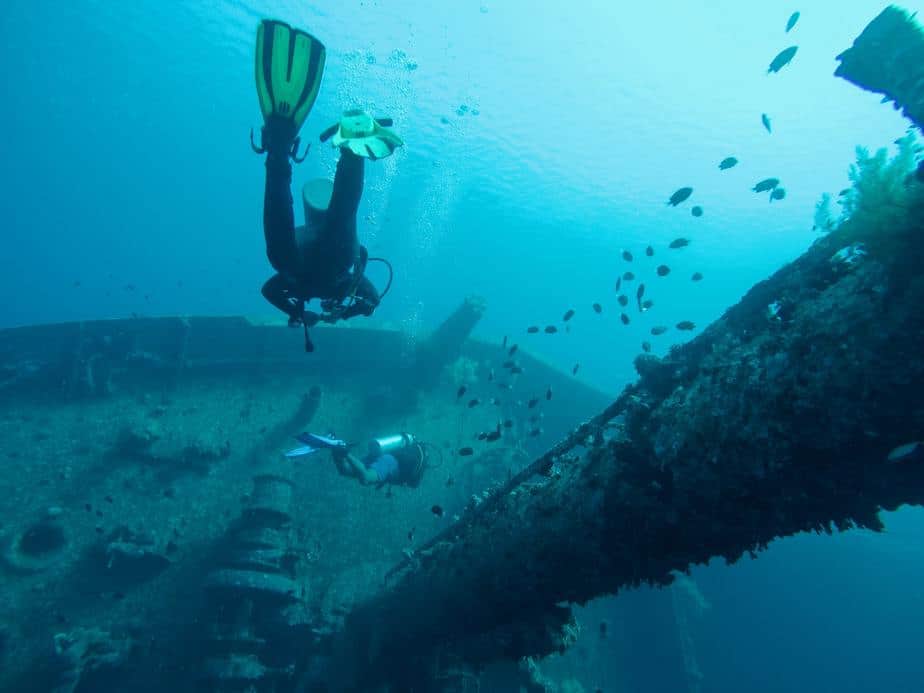In the vast oceans and seas, you will find the wreckage of sunken ships and downed planes. Even in lakes, you may find various wrecks such as a sunken car, bus, excavator, or even a tank! Unfortunately, some of the most famous wrecks, such as the Titanic, are thousands of feet underwater, making them currently impossible for divers to reach. However, there are still plenty of good wrecks to check out.
Some wrecks are very famous and have a lot of history behind them. Furthermore, they vary in their physical condition and size; some are very large, allowing you to enter them and explore the interior. Others are small, or perhaps they have deteriorated to a point where it’s no longer safe to enter. Wreck diving can be very exciting, but also very dangerous if you’re not careful. With the proper training and preparation, you can explore the wrecks relatively safely.
When scuba diving, safety is of utmost importance. When wreck diving, you are taking on even more risks and danger than normal for the sake of an amazing diving experience. In this article, we will try to answer some common questions about wreck diving, such as what exactly it is, what equipment to use, and how you can stay safe while exploring.
What is wreck diving?
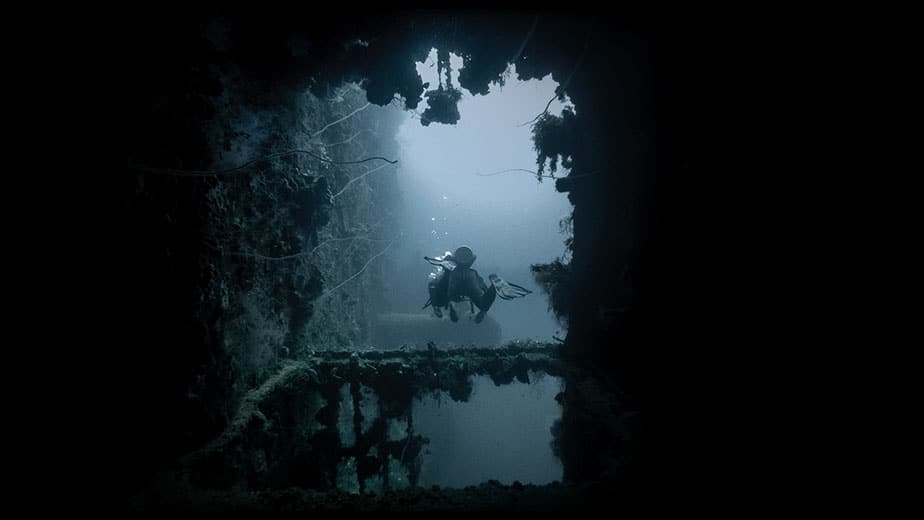
When you first started diving, each descent was fascinating because each experience felt novel; you could expect to see some new colorful fish or sprawling underwater vistas with each dive. However, there are only so many tropical locations you can dive in before things start to feel a bit samey.
With wreck diving, you can explore another facet of diving that is wonderful and exciting. Instead of looking at fish, you can explore a huge ship that sank during World War II or a sunken passenger plane downed due to a tragic accident.
If it isn’t clear, wreck diving is an extreme form of diving and is considered technical diving because of the many risks associated with it. For one, many wrecks are found 30 m (100 ft) underwater or deeper, meaning most divers are not qualified to even dive that deep, let alone explore the wreckage.
Second, the wrecks are often in poor condition. After all, it was damaged enough to sink in the first place and then it deteriorated underwater over many decades until the present day. It’s very likely that the walls of the ship or passenger plane are just one light touch away from collapsing. Visibility is often very poor and it’s easy to get lost or trapped trying to exit the wreck.
As you can see, wreck diving is not without its risks. However, there are a few reasons why you might get a lot of enjoyment out of wreck diving which we explain in the next section.
Why wreck dive?
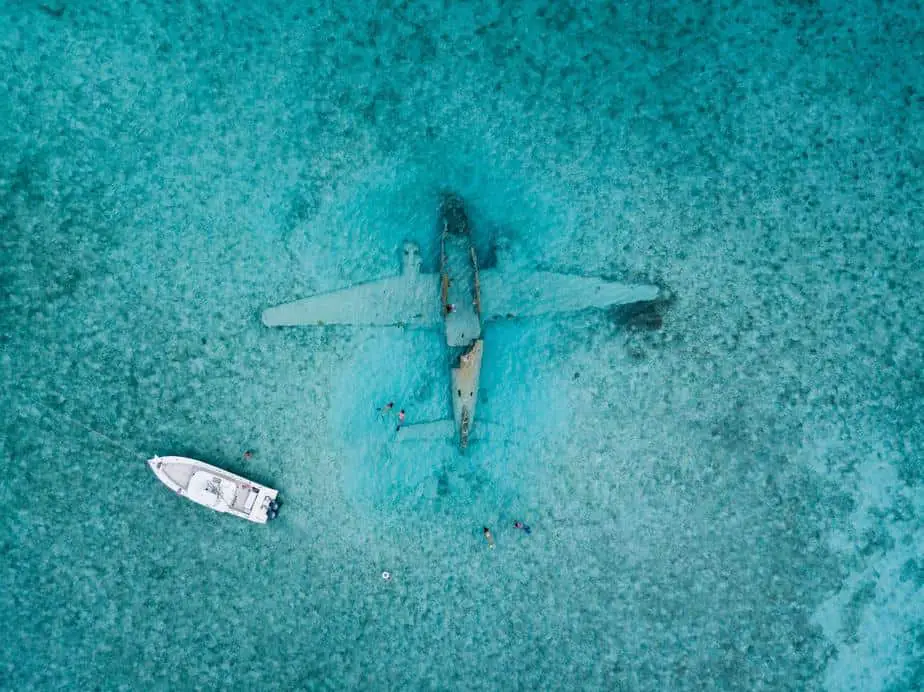
If you have been scuba diving for a while and feel like the sport is starting to get a bit repetitive, then why not change things up? You could get more certifications and try out some specialty dives. Particularly if you’re also a history buff, you can combine your love of history with scuba diving and the result is wreck diving.
Wreck diving is a unique and challenging way to spend your time underwater. Wrecks are the eerie remains of a vessel that was possibly once part of a major historical event, such as a war or a terrible accident. Diving on shipwrecks lets you get a sense of what the vessel might have been like in its glory days. Seeing the vessel up close also helps you get a better understanding of how disastrous the event was that brought it down.
Diving on wrecks, you can better understand the power of nature, the brutality of man, and also just how fragile a man-made object can be. You might even be able to enter the ship to explore the insides. Overall, wreck diving provides such a unique and interesting experience that few other types of diving can match up. You can do it for the adrenaline rush, for the challenge, or for the eerie sights.
What will you find in a wreck?
Not every wreck is as massive as the Titanic. You can find a wide range of wrecks, from small boats to submarines to huge battleships sunk during the war. Some additional interesting wrecks are planes, from passenger planes to fighter planes. You can immerse yourself and swim next to these steel behemoths that have long-since finished their service. You may be able to find wooden hulls of boats sunk hundreds of years ago by pirates or vandals.
It’s unlikely you’ll find treasure or anything of value; you’d have about as much luck trying to win the lottery. When wreck diving, what you should be looking for is a fun and unique experience, not necessarily any objects of value.
Common dangers of wreck diving
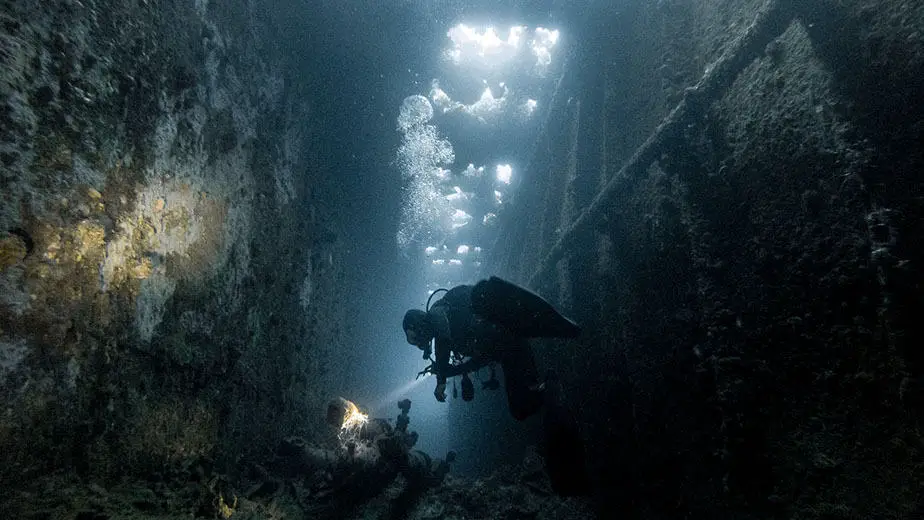
As we mentioned, there are numerous risks associated with wreck diving. In this section, we will cover the most common ones to avoid:
Sharp objects: You will often find damaged sections of the ship or plane that have been creased or torn. This is the result of the force that caused the vessel to sink, but sometimes it may have been caused by the sea. There will be sharp or pointed parts sticking out that can easily injure you during your dive. Be on the lookout for any objects that might puncture your BCD, hoses, or wetsuit.
Currents: Sometimes strong currents will make it impossible for you to penetrate the wreck. Currents can also make reaching the wreck very difficult. If there are strong currents around the wreck, be wary of narrow passages because of the high potential for injury.
Poor visibility: Visibility becomes an issue past a certain depth once the natural light cannot penetrate any further. When wreck diving, visibility will be even lower if you’re entering a shipwreck. Inside a wreck, if you accidentally disturb the layer of silt that has accumulated inside (this situation is called a silt-out), then you can reduce your visibility to zero. Not being able to see will make it easier for divers to get lost or get hurt by protruding parts of the structure. If you feel visibility is too poor, it’s best to end the wreck’s penetration and move on.
Unstable structures: Many wrecks have deteriorated over the years and have become unstable. The floors, ceilings, even the partitions may weaken or bend at the slightest touch. You must not risk entering wrecks whose technical conditions are highly unstable. You may discover that some sections of a shipwreck are more unstable than others. If you sense that section you’re at may be unstable, swim away while making sure not to swim under elements that can collapse.
Braiding: On most wrecks you will find various wires, ropes, and cables. These are all hazards that the diver does not want to get involved in. The worst scenario is when there are a whole network of strings and ropes that have a high risk of entanglement. Avoid areas where there are entanglement hazards, and if you do find yourself tangled up, do not panic. Calmly unsheathe your dive knife or pruning shears and cut the element that is restricting you. If you struggle, you may be tangling yourself even further.
Depth: Some of the best wreck dive sites lie deep underwater, often at deeps exceeding 40 m (130 ft). In order to dive this deep, you need the proper deep diving training. Diving this deep has some natural risks involved. You will have to perform decompression stops most likely, and your breathing gas will not last as long, so make sure you ration some for the ascent.
Marine life: Sometimes wrecks have been inhabited by marine life that are not happy that a strange creature has swam into their territory. Depending on the creature, it may be docile or afraid of you, or it may get angry and attack.
Wreck diving equipment

The basic equipment you need to wreck dive is actually not that different from recreational diving equipment. Diving sidemount can be a huge benefit because it streamlines your profile so you can fit through narrow passages and reduce your chances of getting entangled. However, that is not a necessity, however the equipment mentioned below certainly are.
Reel: You absolutely need a reel cord to mark your return path when wreck diving. It is one of the basic skills you’ll learn about in the wreck diver course.
Knife or pruning shears: Another essential equipment is a dive knife or pruning shear. If you ever get tangled up, this tool will free you from death’s grasp. Thus, you must make sure it’s easily accessible by keeping it within arm’s reach.
Helmet: Helmets are often worn for cave diving, however it can be used for wreck diving for similar reasons. You want to protect your head from any sharp or falling objects. Furthermore, you can attach a camera or light on your helmet to free up your hand.
Lighting: Without a good dive torch, you won’t be able to see. When wreck diving, you want to have a powerful spot dive light that can penetrate through murky water filled with particles and silt. Ideally, it should be a sinking light that doesn’t float away if you need to set it down somewhere. It should also have a long burn time with 1000 lumens. To withstand damage, the light should have a metal or rubber shroud and be attached to your wrist, such as with a lanyard..
Redundancies: Many wreck diving veterans carry additional backup dive computers, depth gauges, spare dive lights, timing devices, pony tanks, compact masks, and the list goes on. One advantage of diving sidemount is that it not only streamlines your profile but also gives you a second tank as backup. The reason why you want to have so many redundancies is because it’s not easy for wreck divers to access the surface. If one of your essential scuba equipment malfunctions, you need to be prepared to handle it without surfacing. Having redundancies will mean the difference between life or death.
Planning a wreck dive
The biggest and most famous wrecks are often found far from shore. You will have to reach the dive site by boat, and you must have a good diving base. By using the right dive center, you will be able to access all of the necessary wreck diving equipment, information about the dive site, and a guide who is familiar with the area.
At the pre-dive briefing, you’ll learn the basic information about the wreck: its location, size, length, when it sank, and how. Learning the history about the wreck will improve your experience because you can better appreciate what you’re exploring. If you’re a history nerd, then this will be twice as enjoyable for you.
Wreck diving certification
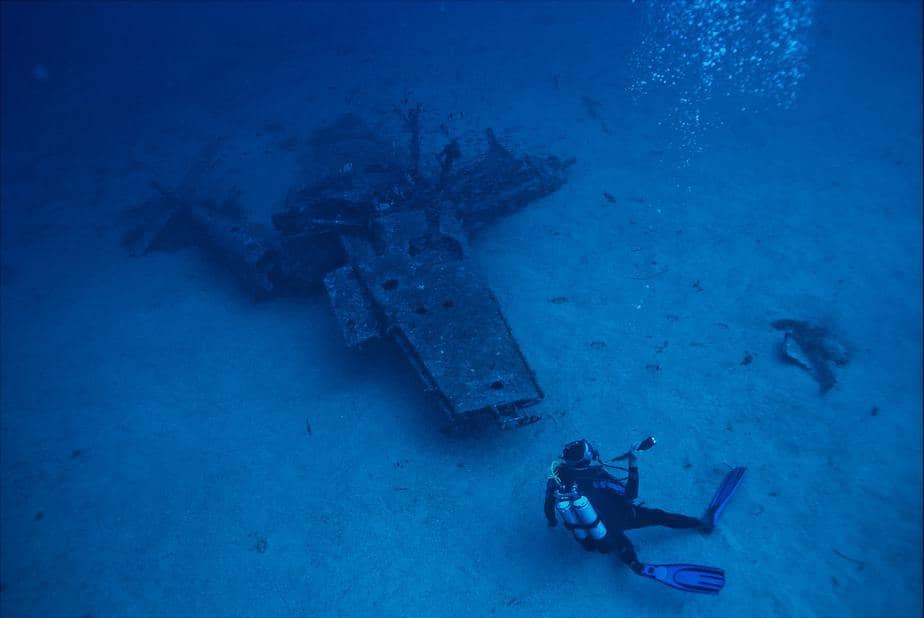
You can never have too much experience or education. Wreck diving is very technical, and it is better to be over-prepared for it than not. Diving on wrecks is too dangerous for you not to take it seriously. Getting your wreck diving certification can help you learn the intricacies of wreck diving so you’ll be prepared for the real thing.
Unlike cave diving, you technically don’t need any certifications to gain access to some dive sites. However, that does not mean all dive charters will allow you to dive without a wreck diver certification. Most will at least request that you are an advanced open water diver at a minimum, otherwise you risk endangering yourself and your dive group.
With that said, some wreck dives require you to have technical diving certifications just because of the depth they are located at. Some more dangerous wrecks will require a wreck diving certification due to the increased risk. Just to be safe, you should take the wreck diver course if you plan on doing plenty of wreck dives. You should be doing it not because it’s required but because you want to stay safe while diving.
Parting words
Sunken wrecks are a great and unforgettable attraction that you can explore once you have the proper training. Many divers fall in love with wreck diving the first time they do it because of how surreal it is to see the wreckage of a real piece of history. It’s an amazing way to satisfy both the history nerd and scuba diving lover within.
Furthermore, wreck diving can be the next stage in a diver’s development from a recreational diver to a technical diver. If you’re looking to push your skills and challenge yourself, then give wreck diving a try. You may be able to dive sidemount or with different gas mixes for the first time which can be an eye-opening experience. As long as you undergo the appropriate training, you can safely enjoy the sunken wrecks of history.

